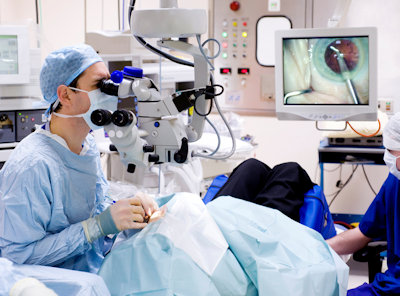Traditional Vs. Laser-Assisted Cataract Surgery
If you need cataract surgery, you may have talked with friends and family who also had the procedure. Some probably had traditional cataract surgery, while others may have had the laser procedure. So the question is: should you have traditional vs. laser-assisted cataract surgery? Which procedure is right for you? The surgeons at Elmquist Eye Group are experts in both procedures, so we will try to distinguish between the two.
Traditional Cataract Surgery
 Millions of people have had traditional cataract surgery. This safe and effective procedure, is also one of the most commonly performed surgeries in the world. This procedure, also known as phacoemulsification, is one of the most common surgeries performed across the globe.
Millions of people have had traditional cataract surgery. This safe and effective procedure, is also one of the most commonly performed surgeries in the world. This procedure, also known as phacoemulsification, is one of the most common surgeries performed across the globe.
The eye surgeon uses a traditional metal surgical blade to create a small incision in the cornea to expose the lens. The surgeon then uses a pen-like ultrasound instrument to break up the protein that has collected on the lens. The broken pieces are suctioned out of the eye, and then an artificial intraocular lens (IOL) is placed in the eye to replace the damaged cloudy lens. Stitches are not needed. Instead, the corneal incision is sealed with a special liquid seal. The procedure is covered by most American insurance plans.
Laser-Assisted Cataract Surgery
Laser-assisted surgery is more technologically advanced. The three-step laser surgery automates many of the steps that are performed manually in the traditional surgery. A laser is used instead of a surgical blade, and an imaging device creates an exact map of the corneal surface to give the surgeon information regarding the location, length and depth of the incision. Rather than using a scalpel, the surgeon creates the incision using a laser, which is also used to soften the cataract proteins. The same ultrasound device is used to break the damaged lens into pieces, then they are suctioned and the IOL is implanted. The incision does not require stitches.
What is the difference?
In both cases, the surgery is performed under local anesthesia, and we can do both procedures on an outpatient basis. Traditional cataract surgery definitely provides excellent results, but the laser procedure offers revolutionary technology for certain surgical cases, meaning Elmquist Eye Group is able to offer patients the best visual outcomes possible.
Certain eye conditions like astigmatism are more suited to the laser-assisted surgery because it is more precise. Patients with astigmatism have elongated curvature of the cornea, and the laser surgery is much better at allowing our surgeons to make a precise corneal map. We can then precisely place a toric lens implant that compensates for and corrects the astigmatism.
Cost is also a differentiator between the two procedures; many insurance plans don’t cover the laser procedure.
When should I have surgery?
Many people have cataracts for years before noticing any symptoms. You should consider cataract surgery if your loss of vision is significant enough to interfere with daily activities. If you cannot perform daily tasks like cooking, reading, driving or watching television without difficulty, it is likely time to have the surgery.
The Elmquist team will evaluate your symptoms and perform a comprehensive eye exam, and based on findings, you and the Elmquist team should decide together when surgery is appropriate. Just remember that cataracts cannot be prevented. We can help slow the progression, but surgery is eventually needed. Left untreated, cataracts will lead to severe vision loss or blindness.
If you suspect or know you have cataracts, come see us at Elmquist Eye Group today so that we can get you on the road to restored vision and help you understand the benefits of laser-assisted cataract surgery vs. traditional cataract surgery.
